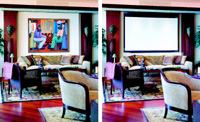That can include half a dozen runs of RG6 coaxial cable to multiple satellite dish locations (determined by line of sight to satellites) and then to all the locations that will have primary TVs. He prescribes an additional three or four more coax runs for the distribution hub so they can feed satellite TV, TiVo-like recorders, and cable sources to the TVs throughout the house.
“We’re doing more TVs in the kitchen now,” Ruderman says, “so we’re running more cables there. In a lot of cases we’re running cable to three or four locations because LCD TVs are so small—and they’ve gotten so affordable—that our clients can afford to put them in a handful of locations.”
Because of the placement opportunities in narrow spaces, Ruderman now finds himself installing plasma TVs in the ceilings of master bedrooms, using specialized lifts to motor the TV from a supine position above the ceiling down to a perpendicular angle for viewing. That location requires not only power and cable runs to the ceiling but additional support as well. “We work with the builder to be sure there’s enough framing with plywood attached to trusses,” he says.
Scott Jordan, system consultant for Electronic Design Group in Piscataway, N.J., says his firm takes framing support to the max for flat-panel TVs. “We sandwich wood pieces between two studs and bolt them in to support the weight of the plasma,” he says. His company’s rule of thumb is that the frame for a TV that hangs on the wall should be able to support five times the weight of the TV. “It’s for peace of mind,” he says.
At several inches deep, plasma and LCD monitors are ideal for positioning over a fireplace. That eliminates two quandaries designers wrestled with for years as video and home theater became more prominent throughout the house: how to hide a massive big-screen TV when it wasn’t being viewed and how to position both the TV and fireplace in the line of sight from the living room sofa.
Jordan, too, reinforces the need for multiple cable runs to all locations that could house a TV. That includes the attic where an off-air antenna might be located for local HD broadcast signals. He suggests power to the attic as well in case a rotor is required to turn the antenna to find different stations.
“The advent of flat-panel TV has been an interior designer’s dream because it has made electronics more attractive,” Jordan says. “But we’re left with the job of finding a home for the other gear.”
Rebecca Day specializing in writing about home electronics. She can be reached at customhomerd@aol.com.



